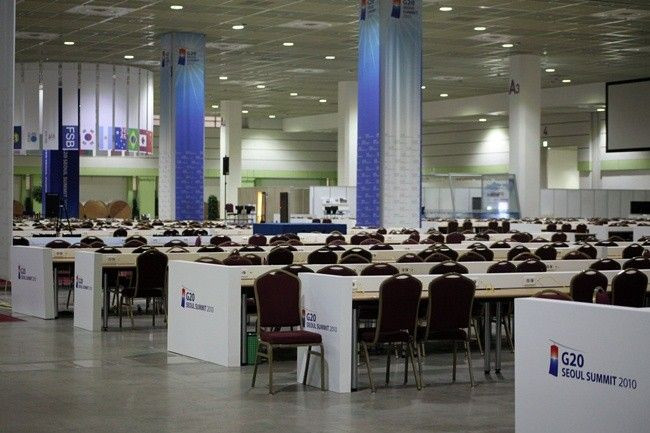Notes From Seoul: After G20, Life Goes On, Quietly

The banners are down. The hotels are emptying out, with travelers gathered in hotel lobbies next to wheelie bags.
It seemed as though every street corner in Seoul had a sign on it asking Koreans to welcome visitors from around the world, with the G20 logo -- a red and blue square that looks something like a luggage tag with a stylized sun at the center -- looking down from every tall building.
On Saturday, the 15-story tall banner that covered the side of a skyscraper to announce the G20 Summit and its theme - Shared Growth, Beyond Crisis -- was dismantled in the space of about an hour. Streetlamps that sported flags announcing to the world that Seoul was a UNESCO-designated City of Design were bare.
A six-foot tall fence ran up Pongeunsaro, and spanned the front of the COEX, where the G20 was held, and again down Teheran-ro. The fence went on for several blocks on either side as well, marking the areas where traffic was funneled to ensure the safety of the arriving dignitaries and control crowds. It was gone by Saturday morning.
The tents set up by the television media for the stand ups (when reporters are standing in front of the camera talking) are gone. Workers were taking down the gigantic structure built to show off the Summit with searchlights.
Inside the COEX was the Media Center. During the summit, hundreds of reporters were seated at rows of tables, filing stories from laptops among piles of notes. Television reporters had set up mobile studios. Gigantic screens were posting briefing schedules and every so often dozens of people were running in some direction when a new press release was issued.
There was a constant buzz from people on the telephone. Areas to work in were staked out and one could walk from one end of the room to the other and hear chatter in French, Chinese, or Korean. In the second hall, some news organizations such as Dow Jones, Agence France-Presse and the Associated Press had set up entire offices.
But on Saturday morning the rooms were quiet. Only a single security guard stood outside the door while workers swept up.The hundreds of chairs, each in front of an Internet connection, were empty.
On Friday, getting into the COEX required a pass (which had to be worn at all times), and running a gauntlet of security guards and metal detectors with airport-style X-ray machines for the bags. The morning after, the guards had left, the metal detectors were packed up, and only a single lone X-ray machine remained -- turned off, and pushed to the side.
City buses had G20 signs on the front, promoting Seoul as the host city. Samseong station was fitted with a Welcome to the G20 Summit sign across the entrance, though on the day that the dignitaries arrived for the summit itself the station was closed. Samseong was open again, though on a Saturday morning the crowds were thin.
Life goes on.
© Copyright IBTimes 2024. All rights reserved.





















